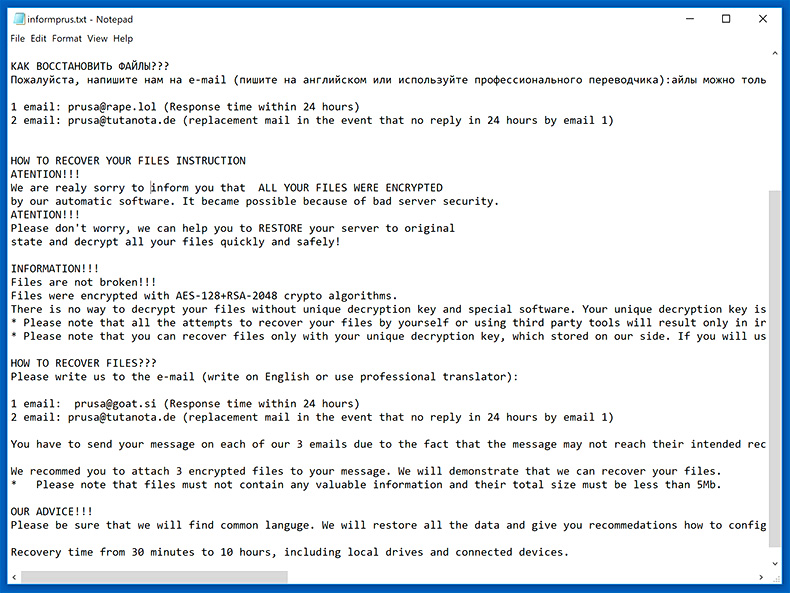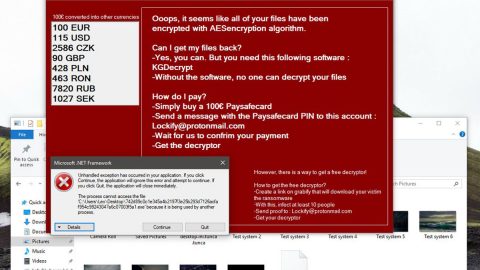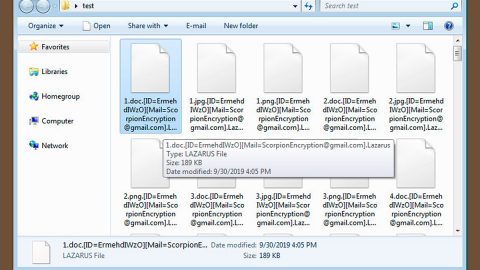What is Prus ransomware? And how does it execute its attack?
Prus ransomware is a crypto-virus discovered lately that can leave files inaccessible after it encrypts them. It seems to be targeting Russian-speaking users as some parts of its ransom note are written in Russian. It uses a “.prus” extension in marking the files it encrypts. Once it starts to execute its attack, it drops its payload file in the system and initiates a sequence of malicious activities with the purpose of plaguing essential system settings and processes. It downloads other malicious components and places them in system folders.

It then modifies the registry keys and sub-keys like Run and RunOnce in the Windows Registry to allow the automatic execution of the attack every time a user turns on the infected computer which makes its attack persistent. It also employs data gathering and stealth protection modules in order to collect sensitive information in the system and to evade security and antivirus programs.
After system modification, Prus ransomware will start to encrypt its targeted files. It mostly targets user-generated files like documents, images, databases, audio files, videos, and so on. Once the encryption is completed, it adds the “.prus” suffix to every compromised file indicating that the file is locked. It then drops a text file named “informprus.txt”. Here are some parts of its ransom note written in English:
“ATTENTION!!!
We are really sorry to inform you that ALL YOUR FILES WERE ENCRYPTED
by our automatic software. It became possible because of bad server security.
ATTENTION!!!
Please don’t worry, we can help you to RESTORE your server to original
state and decrypt all your files quickly and safely!
INFORMATION!!!
Files are not broken!!!
Files were encrypted with AES-128+RSA-2048 crypto algorithms.
There is no way to decrypt your files without a unique decryption key and special software. Your unique decryption key is securely stored on our server. For our safety, all information about your server and your decryption key will be automatically DELETED AFTER 7 DAYS! You will irrevocably lose all your data!
* Please note that all the attempts to recover your files by yourself or using third-party tools will result only in irrevocable loss of your data!
* Please note that you can recover files only with your unique decryption key, which is stored on our side. If you will use the help of third parties, you will only add a middleman.
HOW TO RECOVER FILES???
Please write us to the e-mail (write in English or use a professional translator):
1 email: [email protected] (Response time within 24 hours)
2 email: [email protected] (replacement mail in the event that no reply in 24 hours by email 1)
You have to send your message on each of our 3 emails due to the fact that the message may not reach its intended recipient for a variety of reasons!
We recommend you attach 3 encrypted files to your message. We will demonstrate that we can recover your files.
* Please note that files must not contain any valuable information and their total size must be less than 5Mb.
OUR ADVICE!!!
Please be sure that we will find a common language. We will restore all the data and give you recommendations on how to configure the protection of your server.
Recovery time from 30 minutes to 10 hours, including local drives and connected devices.
We will definitely reach an agreement 😉 !!!”
How does Prus ransomware spread online?
The malicious payload of Prus ransomware may be distributed using several ways but the most common method used is a malicious spam email campaign. Cybercriminals tend to attach files like document or PDF file which contains macro scripts used to launch the ransomware in the system. Aside from that, Prus ransomware can also spread via malicious JavaScripts, third-party downloads, and so on.
Wipeout Prus ransomware by using the removal guide provided below.
Step_1: First, tap the Ctrl + Shift + Esc keys on your keyboard to open the Task Manager.
Step_2: Under the Task Manager, go to the Processes tab and look for any suspicious-looking process that takes up most of your CPU’s resources and is most likely related to Prus ransomware.
Step_3: After that, close the Task Manager.
Step_4: Tap Win + R, type in appwiz.cpl and click OK or tap Enter to open Programs and Features under Control Panel.
Step_5: Under the list of installed programs, look for Prus ransomware or anything similar and then uninstall it.
Step_6: Next, close the Control Panel and tap Win + E keys to launch File Explorer.
Step_7: Navigate to the following locations below and look for Prus ransomware’s malicious components such as informprus.txt and [random].exe and other suspicious files, then delete all of them.
- %TEMP%
- %WINDIR%\System32\Tasks
- %APPDATA%\Microsoft\Windows\Templates\
- %USERPROFILE%\Downloads
- %USERPROFILE%\Desktop
Step_8: Close the File Explorer.
Before you proceed to the next steps below, make sure that you are tech-savvy enough to the point where you know exactly how to use and navigate your computer’s Registry. Keep in mind that any changes you make will highly impact your computer. To save you trouble and time, you can just use Restoro, this system tool is proven to be safe and excellent enough that hackers won’t be able to hack into it. But if you can manage Windows Registry well, then by all means go on to the next steps.
Step_9: Tap Win + R to open Run and then type in Regedit in the field and tap enter to pull up Windows Registry.
Step_10: Navigate to the following path:
- HKEY_CURRENT_USER\Control Panel\Desktop\
- HKEY_USERS\.DEFAULT\Control Panel\Desktop\
- HKEY_LOCAL_MACHINE\Software\Microsoft\Windows\CurrentVersion\Run
- HKEY_CURRENT_USER\Software\Microsoft\Windows\CurrentVersion\Run
- HKEY_LOCAL_MACHINE\Software\Microsoft\Windows\CurrentVersion\RunOnce
- HKEY_CURRENT_USER\Software\Microsoft\Windows\CurrentVersion\RunOnce
Step_11: Delete the registry keys and sub-keys created by Prus ransomware.
Step_12: Close the Registry Editor and empty the Recycle Bin.
Try to recover your encrypted files using the Shadow Volume copies
Restoring your encrypted files using Windows Previous Versions feature will only be effective if Prus ransomware hasn’t deleted the shadow copies of your files. But still, this is one of the best and free methods there is, so it’s definitely worth a shot.
To restore the encrypted file, right-click on it and select Properties, a new window will pop up, then proceed to Previous Versions. It will load the file’s previous version before it was modified. After it loads, select any of the previous versions displayed on the list like the one in the illustration below. And then click the Restore button.
Congratulations, you have just removed Prus Ransomware in Windows 10 all by yourself. If you would like to read more helpful articles and tips about various software and hardware visit fixmypcfree.com daily.
Now that’s how you remove Prus Ransomware in Windows 10 on a computer. On the other hand, if your computer is going through some system-related issues that have to get fixed, there is a one-click solution known as Restoro you could check out to resolve them.
This program is a useful tool that could repair corrupted registries and optimize your PC’s overall performance. Aside from that, it also cleans out your computer for any junk or corrupted files that help you eliminate any unwanted files from your system. This is basically a solution that’s within your grasp with just a click. It’s easy to use as it is user-friendly. For a complete set of instructions in downloading and using it, refer to the steps below
Perform a full system scan using Restoro. To do so, follow the instructions below.













